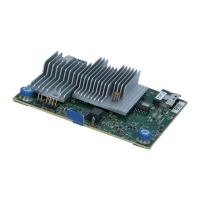SubtopicsSubtopics
RAID 5RAID 5
RAID 50RAID 50
RAID 6RAID 6
RAID 60RAID 60
Parity groupsParity groups
InitializeInitialize
Regenerative writesRegenerative writes
Backed-out writesBacked-out writes
Full-stripe writesFull-stripe writes
RAID 5RAID 5
RAID 5 protects data using parity (denoted by Px,y in the figure). Parity data is calculated by summing (XOR) the data from each drive within the stripe. The
strips of parity data are distributed evenly over every physical drive within the logical drive. When a physical drive fails, data that was on the failed drive can be
recovered from the remaining parity data and user data on the other drives in the array. The usable capacity is C x (n - 1) where C is the drive capacity with n
drives in the array. A minimum of three drives is required.
The maximum number of drives supported for RAID 5 is 32.
This method has the following benefits:
It is useful when usable capacity, write performance, and data protection are equally important.
It has the highest usable capacity of any fault-tolerant configuration.
Data is not lost if one physical drive fails.
RAID 50RAID 50
RAID 50 is a nested RAID method in which the constituent drives are organized into several identical RAID 5 logical drive sets (parity groups). The smallest
possible RAID 50 configuration has six drives organized into two parity groups of three drives each.

